
Old Church
"Desperate skirmish at Old Church, near Tunstall's Station, VA., between a squadron of the Fifth United…
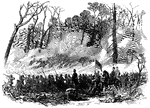
Battle of Shiloh
"Battle of Shiloh, or Pittsburg Landing, left wing- the woods on fire during the engagement of Sunday,…

Westfield
"Fire raft sent down from Fort Jackson to destroy the Federal fleet below the fort- the boats of the…

Massachusetts Battery
Martin's Massachusetts Battery C opening fire on the Confederate fortifications commanding the approaches…
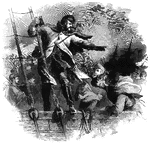
Burnside Expedition
"Burnside Expedition- the fleet and transports off Hatteras during the storm- the general giving orders.…

Federal Kitchen
"The Federal Kitchen on the march to Fredericksburg with three days' rations." — Frank Leslie,…
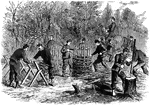
77th Pennsylvania Regiment
"Captain Muller's Battery Company of the Seventy-seventh Pennsylvania Regiment making fascines and gabions…

Captain Knapp
"Captain Knapp's Battery engaging the Confederates at the battle of Cedar Mountain, August 9th, 1862-…
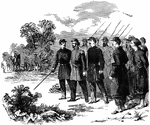
Major Taylor
"Escorting Major Taylor, of New Orleans, the bearer of a flag of truce, blindfolded, to the Confederate…
!["First and last review of the First Regiment, South Carolina [African American] Volunteers, on Hilton Head, S. C., under Colonel Fessenden, U. S. A., June 25th, 1862. Our correspondent at Hilton Head wrote us: "I witnessed the parade entire, as well as the company drills in the manual of arms, etc., afterward, and I must acknowledge my complete surprise at the discipline and even vim evinced by the sable crowd. Dressed in the regulation uniform of the United States Army, tall and strong men generally speaking, they, considering that the regiment had not been fully armed but about ten days, spoke well for officers and men."" — Frank Leslie, 1896](https://etc.usf.edu/clipart/11000/11043/1stregiment_11043_mth.gif)
First Regiment
"First and last review of the First Regiment, South Carolina [African American] Volunteers, on Hilton…

Battle of Cedar Mountain
"Gordon's and Crawford's Brigades driving the Confederate forces from the woods at the Battle of Cedar…
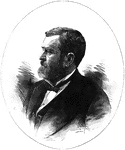
Ulysses Grant
General Grant, eighteenth President of the United States, born at Point Pleasant, Clermont County, Ohio,…
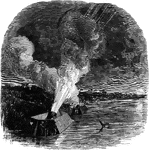
Siege of Island
"Siege of Island No. 10, on the Mississippi River- night bombardment by the Federal mortar boats, ten…

Great Bakery
"The Great Bakery for the United States Army at the Capitol, Washington, D. C.- sketched by our special…
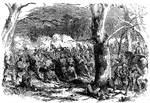
Storming of Fort Donelson
"Storming of Fort Donelson- decisive bayonet charge of the Iowa Second Regiment on the Confederate intrenchments…

Great Falls
"Shelling Confederate cavalry across the Potomac River from the heights of Great Falls, by Major West,…

Munson's Hill
"Skirmishing between the pickets of the two armies near Munson's Hill- the hill in the distance. Munson's…

Craney Island
"Blowing up the Confederate forts on Craney Island, by Commodore Goldsborough, June 2nd 1862." —…

Bombardment of Island No. 10
"Bombardment of Island No. 10 and the fortifications opposite, on the Kentucky Shore, by the Federal…

Battle of Cedar Mountain
"The Confederate batteries shelling the Federal position on the night of the Battle of Cedar Mountain,…

Battle of Winchester
"Battle of Winchester, VA., March 23rd, 1862- decisive bayonet charge of the Federal troops, led by…
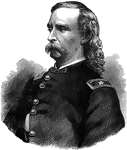
George Custer
"General George A. Custer, born in New Rumley, Harrison County, Ohio, December 5th, 1839, died in Montana,…
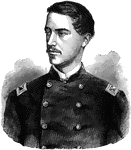
Ulric Dahlgren
"Colonel Ulric Dahlgren, born in Bucks County, Pa., in 1842, died near King and Queen's Courthouse,…
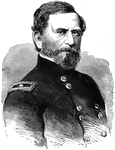
J. T. Sprague
"General J. T. Sprague, born in Newburyport, Mass., July 3rd, 1810, died in New York city, September…
!["General Lorenzo Thomas, born in Newcastle, Del., October 26th, 1804, died in Washington, D. C., March 2nd, 1875, was graduated from the United States Military Academy in 1823; served in the Florida and Mexican Wars, and received the brevet of lieutenant colonel for gallantry at Monterey. On the 7th of May, 1861, he was brevetted brigadier general, and made adjutant general of the army on August 3rd, with the full rank of brigadier general. He served until 1863, when he was intrusted for two years with the organization of [African American] troops in the Southern States. He was brevetted major general, United States Army, on March 13th, 1865. He was retired in 1869." — Frank Leslie, 1896](https://etc.usf.edu/clipart/11000/11059/thomas_11059_mth.gif)
Lorenzo Thomas
"General Lorenzo Thomas, born in Newcastle, Del., October 26th, 1804, died in Washington, D. C., March…
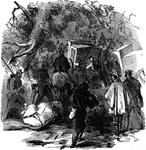
March of General Banks
"Incident in the march of General Banks's Division during a storm in Western Maryland." — Frank Leslie,…
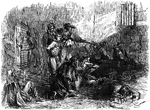
Prison
"The humors of a prison- scene in a station-house cell, Washington, D. C., after the appointment of…

Attack at Harrisonburg
"Gallant attack by 150 of the Pennsylvania Bucktails, led by Colonel Kane, upon a portion of General…

Pontoon bridge
"General Fremont's Division crossing the Pontoon Bridge over the Shenandoah River in pursuit of the…

Adams Express
"Scene in Adams Express office, at Fortress Monroe, VA., in 1861- Volunteers receiving letters and packages…
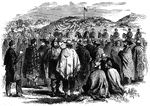
Confederate Prisoners
"Group of Confederate prisoners captured at Fort Donelson, on the morning after the surrender, clothed…
New Jersey Troops
"The New Jersey troops crossing the Chesapeake Bay, in sixteen propellers, on their way to Washington,…

First naval battle
"First naval battle in Hampton Roads between the Confederate iron-plated steamers Merrimac, Yorktown,…

Second Naval Battle
"Second naval battle in Hampton Roads- fight between the Federal ironclad Monitor, of two guns,…

Fort Hatteras
"General view of Forts Hatters and Clark, N. C., captured on the 29th of August, 1861, by the Federal…

Valley of Chickahominy
"Valley of the Chickahominy, looking southeast from the vicinity of Mechanicsville, the scene of the…

Officer's Tents
"New Jersey Camp at Arling, Va., designated as Camp Princeton in honor of one of the Revolutionary battle…
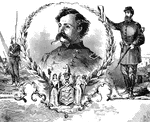
Theodore Runyon
"New Jersey Camp at Arling, Va., designated as Camp Princeton in honor of one of the Revolutionary battle…
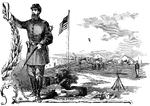
Aid-de-camp
"New Jersey Camp at Arling, Va., designated as Camp Princeton in honor of one of the Revolutionary battle…

Camp Princeton
"New Jersey Camp at Arling, Va., designated as Camp Princeton in honor of one of the Revolutionary battle…

Burning of the White House
"Burning of the White House- the Federal troops, by command of General McClellan, abandoning their position…

Burning of Confederate gunboats
"Burning of the Confederate gunboats, rams, etc., at New Orleans and Algiers, on the approach of the…

Camp Dennison
"Camp Dennison, sixteen miles above Cincinnati, on the banks of the Miami River, General Cox commanding-…

Battle at Potomac
"Engagement between the Federal troops and the Confederates on the Virginia side of the Potomac, opposite…

Engagement at Romney
"Engagement at Romney, VA., twenty miles from New Creek, Tuesday, June 11th, 1861- the Eleventh Indiana…

Fort Norfolk
"Old Fort Norfolk, built by the Federal government, but altered and strengthened by the Confederates."…

Battle of Pea Ridge
"Battle of Pea Ridge, Ark., fought March 6th, 7th and 8th, 1862, between the Federal forces, 13,000…
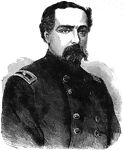
Edward Ferrero
"General Edward Ferrero was born in Granada, Spain, January 18th, 1831. His parents were Italian, and…
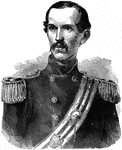
Michael Corcoran
"General Michael Corcoran, born in Carrowkeel, County Sligo, Ireland, September 21st, 1827, died near…
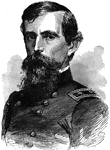
Lewis Wallace
"General Lewis Wallace, born in Brookville, Frankly County, Ind., April 10th, 1827, served in the Mexican…
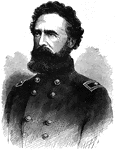
George Sykes
"General George Sykes, born in Dover, Del., October 9th, 1822, died in Brownsville, Texas, February…

Military authorities
"The military authorities at Washington, D. C., examining passes in 1861. This scene was of frequent…
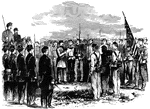
Seventy-ninth Regiment
"Taking away the colors of the Seventy-ninth New York Regiment for insubordination and mutiny, Washington,…
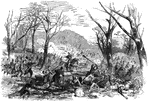
Battle of Mill Spring
"Battle of Mill Spring, on the Cumberland River, near Jamestown, between a confederate force, 8,000…
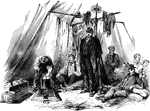
Thirteenth Illinois Volunteers
"Scene in camp life- company mess of the Thirteenth Illinois Volunteers in their camp before Corinth,…

First Minnesota Regiment
"Fort built around the officer's quarters of the First Minnesota Regiment, Colonel Sully, near Fair…

Battle of Charles City
"Battle of Charles City Road- charge of the Jersey Brigade- the first New Jersey brigade, General Tayler,…

Crossing of Shenandoah River
"Colonel Pilson's Battery shelling the rear guard of the Confederate General Jackson's Army, at the…
